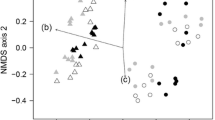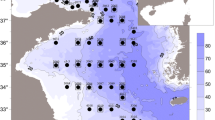Abstract
The mobile component of a community inhabiting a submarine boulder scree/cliff was investigated at Lough Hyne, Ireland at dawn, midday, dusk and night over a 1-week period. Line transects (50 m) were placed in the infralittoral (6 m) and circumlittoral (18 m) zones and also the interface between these two zones (12 m). The dominant mobile fauna of this cliff consisted of echinoderms (6 species), crustaceans (10 species) and fish (23 species). A different component community was identified at each time/depth interval using Multi-Dimensional Scaling (MDS) even though both species diversity (Shannon–Wiener indices) and richness (number of species) remained constant. These changes in community composition provided indirect evidence for migration by these mobile organisms. However, little evidence was found for migration between different zones with the exception of the several wrasse species. These species were observed to spend the daytime foraging in the deeper zone, but returned to the upper zone at night presumably for protection from predators. For the majority of species, migration was considered to occur to cryptic habitats such as holes and crevices. The number of organisms declined during the night, although crustacean numbers peaked, while fish and echinoderms were most abundant during day, possibly due to predator-prey interactions. This submarine community is in a state of flux, whereby, community characteristics, including trophic and energetic relationships, varied over small temporal (daily) and spatial (m) scales.
Similar content being viewed by others
References
Allen, P. L., 1983. Feeding behaviour of Asterias rubens on soft bottom bivalves: a study in selective predation. J. exp. mar. Biol. Ecol. 70: 79–90.
Anderson, T.W., 1994. Role of macroalgal structure in the distribution and abundance of a temperate reef fish. Mar. Ecol. Prog. Ser. 113: 279–290.
Angel, A. & F. P. Ojeda, 2001. Structure and trophic organisation of subtidal fish assemblages on the northern Chilean coast: the effect of habitat complexity. Mar. Ecol. Prog. Ser. 21: 81–91.
Anger, K., U. Rogal, G. Schriever & C. Valentin, 1977. In situ investigations on the echinoderm Asterias rubens as a predator of soft-bottom communities in the western Baltic sea. Helgol. wiss. Meeresunters. 29: 439–459.
Barnes, D. K. A. & A. C. Crook, 2001. Quantifying behavioural determinants of the coastal European sea-urchin Paracentrotus lividis. Mar. Biol. 138: 1205–1212.
Barshaw, D. E. & E. Spanier, 1994. Antipredator behaviours of the Mediterranean clipper lobster, Scyllarides latus. Bull. mar. Sci. 55: 375–382.
Bassindale, R., E. Davenport, F. J. Ebling, J. A. Kitching, M. A. Sleigh & J.F. Sloane, 1957. The ecology of Lough Hyne rapids with special reference to water currents. VI. Effects of the rapids on the hydrography of the south basin. Ecology 45: 879–900.
Coleman, M. A., 2002. Small-scale variability in intertidal and subtidal turfing algal assemblages and the temporal generality of these patterns. J. exp. mar. Biol. Ecol. 267: 53–74.
Crook, A. C., M. Long & D. K. A. Barnes, 2000. Quantifying daily migrations in the sea urchin Paracentrotus lividis. J. mar. biol. Ass. U.K. 80: 177–178.
De Grave, S. & J. R. Turner, 1997. Activity rhythms of the squat lobsters, Galathea squamifera and G. strigosa (Crustacea: Decapoda: Anomura) in south west Ireland. J. mar. biol. Ass. U.K. 77: 273–276.
Ellis, J. R. & S. E. Shackley, 1997. The reproductive biology of Scyliorhinus canicula in the Bristol Channel, U.K. J. Fish Biol. 51: 361–372.
Fjosne, K. & J. Gjosaeter, 1996. Dietary composition and the potential of food competition between 0-group cod (Gadus morhua L.) and some other fish species in the littoral zone. ICES J. mar. Sci. 53: 757–770.
Forward, R. B., R. A. Tankersley & P. N. Pochelon, 2003. Circatidal activity rhythms in ovigerous blue crabs, Callinectes sapidus: implications for ebb tide transport during the spawning migrations. Mar. Biol. 142: 67–76.
Greenwood, A., D. K. A. Barnes, R. M. O'Riordan & G. M. Burnell, 1999. Asteroid diversity and abundance in Lough Hyne Ireland. In Candia Carnevalia, M. D. & F. Bonasoro (eds), Proceedings of the Fifth European Conference on Echinoderms, Milan, Italy. A.A. Balkema, Rotterdam: 481–486.
Guidetti, P. & S. Bussotti, 2000. Fish fauna of a mixed meadow composed by the seagrasses Cymodocea nodosa and Zostera noltii in the Western Mediterranean. Oceanolgia Acta 23: 759–770.
Hubálek, Z., 2000. Measures of species diversity in ecology: an evaluation. Folia Zool. 49: 241–260.
Kelly, S., 2001. Temporal variation in the movement of the spiny lobster Jasus edwardsii. Mar. Freshwat. Res. 52: 323–331.
Lowry, M. B. & I. M. Suthers, 1998. Home range, activity and distribution patterns of a temperate rocky-reef fish, Cheilodactylus fuscus. Mar. Biol. 132: 569–578.
Nickell, L. A. & M. D. J. Sayer, 1998. Occurrence and activity of mobile macrofauna on a sublittoral reef: diel and seasonal migrations. J. mar. biol. Ass. U.K. 78: 1061–1082.
Ohman, M. C. & A. Rajasuriya, 1998. Relationships between habitat structure and fish communities on coral and sandstone reefs. Environ. Biol. Fish. 53: 19–31.
Palma, A. T. & F. P. Ojeda, 2002. Abundance, distribution and feeding patterns of a temperate reef fish in subtidal environments of the Chilean coast: the importance of the understory algal turf. Rev. Chilena De Hist. Nat. 75: 189–200.
Ramsey, K., J. R. Turner, S. J. Vize & C. A. Richardson, 2000. A link between predator density and arm loss in the starfish Marthasterias glacialis and Asterias rubens. J. mar. biol. Ass. U.K. 80: 565–566.
Price, J. H., 1984. The distribution of benthic marine algae - a bibliography of the British Isles. Brit. Phycol. J. 19: 385–404.
Rhode, S. C., M. Pawlowski & R. Tollrian, 2001. The impact of ultraviolet radiation on the vertical distribution of zooplankton of the genus Daphnia. Nature 412: 69–72.
Sayer, M. D. J., J. W. Treasurer & M. J. Costello, 1996. Wrasse: Biology and use in Aquaculture. Fishing News Books. 283 pp.
Shepherd, S. A. & P. S. Clarkson, 2001. Diet, feeding behaviour, activity and predation of the temperate blue-throated wrasse, Notolabrus tetricus. Mar. Freshwat. Res. 52: 311–322.
Sumich, J. L. & C. K. Erickson, 1992. Gray whale migrations. Currents 11: 23-25. 182
Turner, J. R. & C. G. Warman, 1991. The mobile fauna of the sublittoral cliffs. In Myers, A. A., C. Little, M. J. Costello & J. C. Partridge (eds), The Ecology of Lough Hyne: Proceeding of a Conference 4-5th September 1990. Royal Irish Academy, Dublin: 127–138.
Uglem, I & G. Rosenqvist, 2002. Nest building and mating in relation to male size in Corkwing wrasse, Symphodus melops. Environ. Biol. Fish 63: 17–25.
Vost, L. M., 1983. The influence of Echinus Esculentus grazing on subtidal algal communities. Brit. Phycol. J. 18: 211–221.
Worthington, D. G., S. E. McNeill, D. J. Ferrell & J. D. Bell, 1995. Large scale variation in the abundance of five common species of decapod sampled from seagrass in New South Wales. Aust. J. Ecol. 20: 515–525.
Author information
Authors and Affiliations
Rights and permissions
About this article
Cite this article
Bell, J.J., Turner, J.R. Temporal and spatial variability of mobile fauna on a submarine cliff and boulder scree complex: a community in flux. Hydrobiologia 503, 171–182 (2003). https://doi.org/10.1023/B:HYDR.0000008497.66443.03
Issue Date:
DOI: https://doi.org/10.1023/B:HYDR.0000008497.66443.03




